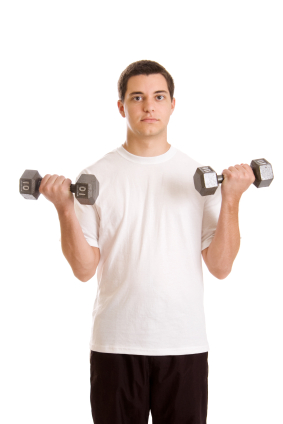When athletes see a hit coming, they instinctively flex their neck muscles. Since it is the acceleration of the brain after a force is applied or transmitted to the head that results in concussion, reducing the acceleration of the head after impact can reduce the risk of sustaining a sport-related concussion. One way to do that is by strengthening the neck muscles.
A pilot study1 suggests that overall neck strength is a statistically significant predictor of concussion, with the odds of concussion falling by 5% for every one pound increase in neck strength.
Fortunately, neck strengthening exercises are easy to do and don't require a huge investment in equipment.
Here are some simple strengthening exercises which athletes can add to their current resistance training:
- Shrugs: A common resistance exercise which can be performed either with a barbell or dumbbells. The easiest way may be for the athlete to hold a dumbbell of appropriate weight in each hand, with the arms extended at the side, and then raise their shoulders, lifting the weight of the dumbbell, and then slowly relaxing to the starting position.
- Dumbbell press: For the dumbbell press, the athlete raises their arms so that the elbows are even with the shoulders and flexed at approximately 90 degrees. From this starting position, the athlete then raises the dumbbell doward the cieling while
 straightening the elbow. Then, the dumbbell is returned to the starting position.
straightening the elbow. Then, the dumbbell is returned to the starting position. - Lateral, forward, backward, and rotational resistence exercises of the neck. Athletes playing for teams with significant resources will often have a machine that is specifically designed to help them strengthen the neck muscles. There are, however, some very simple resistance exercises athletes without such resources can still do which are perhaps the easiest and most effective ways to strengthen the neck muscles.
In order to perform lateral resistence exercises, an athlete places their right hand on the right side of their head. The muscles of the neck are flexed so that the right ear attempts to move downward towards the right shoulder, but, because the athlete is resisting that action, the head doesn't actually move. The athlete should hold this position in active resistance for about 5 to 10 seconds. The exercise can then be performed on the left side of the head, front of the head, and back of the head.
The rotational resistence exercises are similar: the athlete places their hand against the side of the forehead and then attempts to rotate the head towards the right or the left while nodding "no." This motion is resisted by the hand so there is no actual movement of the head. Again, the athlete should hold the position in active resistence for about 5 to 10 second and then repeat in the opposite direction.
Proper supervision on technique
As with all resistence training, particularly in younger athletes, the emphasis should be on proper and safe technique. Younger athletes who are unfamiliar with resistence training should be coached and supervised by an adult with expertise in resistance training of the pediatric athlete. The descriptions outlined above are for descriptive purposes only; anyone planning on engaging in them should consult a proper manual or seek professional assistance.
Adapted from Kids, Sports, and Concussion (Praeger 2011)
1. Gregory S. "Neck Strength Predicts Concussion Risk, Study Says" (http://keepingscore.blogs.time.com/2013/02/21/study-neck-strength-predic...)(accessed February 22, 2013), citing Comstock R.D. High School Sports-Related Injury: Recent Trends and Research Findings. Presented at the National Youth Sports Safety Summit, Washington, D.C., February 5, 2013.
Posted November 5, 2012; updated February 22, 2013 to reflect the research paper presented by R. Dawn Comstock at the 4th Annual Youth Sports Safety Summit on February 5, 2013 in Washington, D.C.








